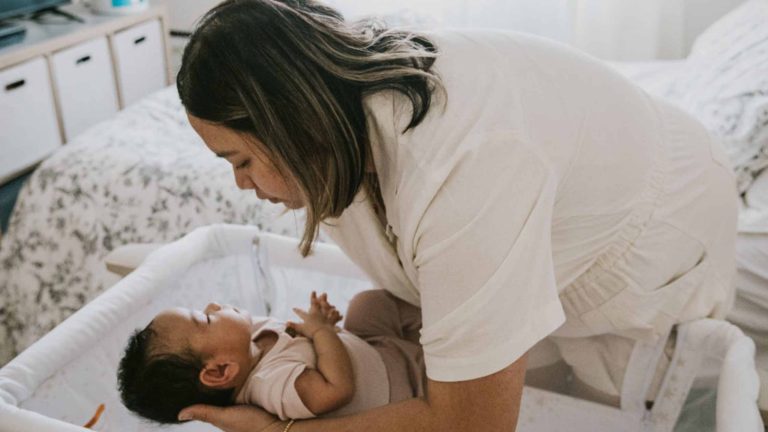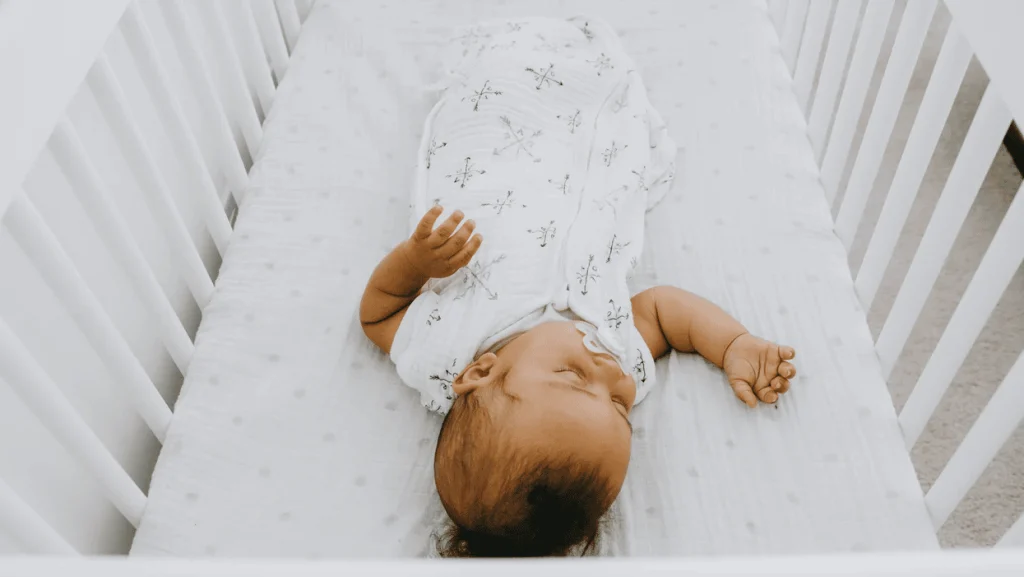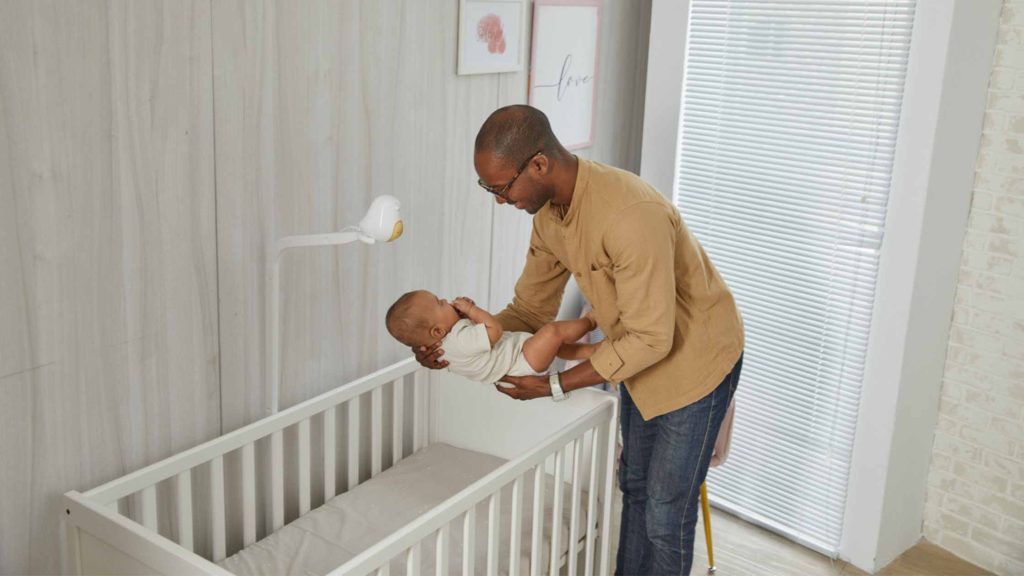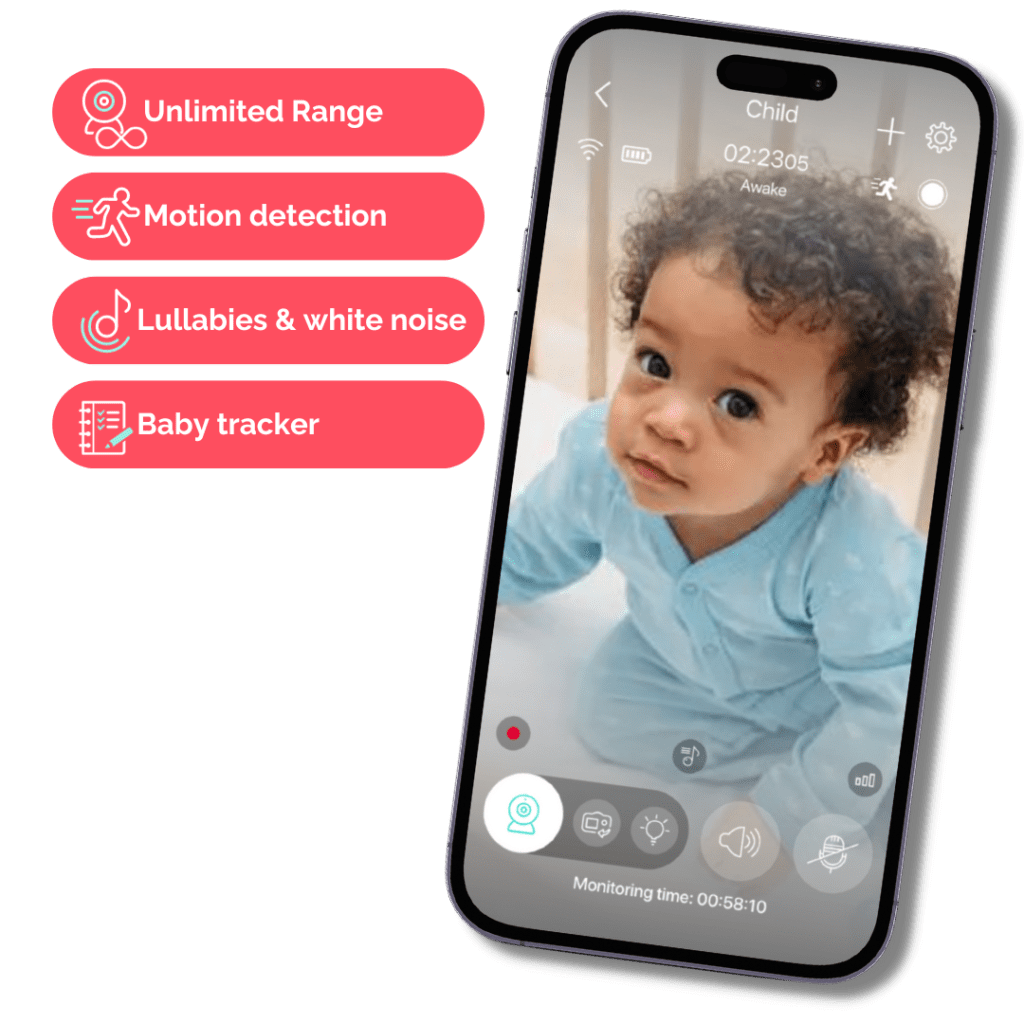
Where Should Newborn Sleep? Create a Safe Sleep Environment for Baby!
- Created:
31. 1. 2023 - Updated:
15. 2. 2024
It’s a fact:
A safe sleep environment is crucial for newborns and infants.
While there are many things you can do to ensure your baby is safe during sleep. It’s important to understand where should newborn sleep and what goes into creating a safe sleep environment.
In this article:
We’ll discuss everything from where should newborn sleep, what should baby wear at bedtime to how to get rid of all the dangers.
Where Should Newborn Sleep?
The safest way for your baby to sleep is on their back on a firm, flat surface (like a crib mattress) without any blankets or pillows and stuffed animals around them. Loose bed sheets, blankets, crib bumpers, pillows, or toys with strings or ribbons are the most common danger for the baby.

Place Baby to Sleep on His Back, Never on Stomach
When you place your baby on his back to sleep, you’re helping to prevent Sudden Infant Death Syndrome (SIDS). Placing a baby on stomach has been linked to an increased incidence of SIDS.
Because of this risk, it’s important that you keep your baby safe while sleeping by following these three steps:
- Never put your infant down for naps in an adult bed; instead use a bassinet or crib designed specifically for infants under 12 months old.
- Make sure all mattresses are firm and fit snugly around the sides of the mattress frame (if applicable) with no gaps where small fingers or limbs could become trapped between gaps in the mattress and frame edge.
- Also, make sure there are no sharp edges along any part of the crib. Such as slats or wood trimming along the headboard/footboard area. Which could cause injury if rubbed against during sleep activities such as rolling over onto the stomach position during deep sleep cycles.
Make Your Baby’s Sleep Area Comfortable and Safe
The first step to creating a safe sleep environment for your baby is making sure that the crib itself is safe.
Make sure the mattress fits snugly in the crib and does not have any tears or holes.
If you have an old mattress, consider replacing it with a new one–mattresses can wear out over time. Especially if they’re made from foam or other materials that aren’t durable enough to last as long as you want them too.
Also, make sure that your baby isn’t sleeping on an overly soft or hard surface. These conditions can cause back pain when the child grows up (and maybe even now).
Keep Soft Objects Out of Baby’s Crib
Babies should not sleep on soft or fluffy beds.
Firm cribs are best. And it’s important to fit the sheet tightly around mattress so no parts of your baby’s body can get caught in the gap.
In addition, make sure that the crib is firm and has a tight-fitting sheet.
If you’re worried about baby getting cold, try using a swaddle instead of a blanket! And never use pillows or other soft objects, blankets.
Don’t Use Loose Bedding or Blankets in Baby’s Crib
Babies can get tangled up in loose bedding, which can pose a suffocation risk.
In addition to these dangers:
Loose blankets may pose strangulation hazards if they get wrapped around your baby’s neck while sleeps. And this is especially danger for babies who are learning how to roll over on their own.
So what should you do instead?
Invest in breathable crib bumpers that will keep your little one safe from falling out of bed but won’t lead baby into danger either.
Crib bumpers are a simple, affordable way to keep your baby safe while baby sleeps.
They provide a soft barrier between your baby and the hard sides of baby’s crib. Which can help prevent from getting hurt if baby bumps into them while reaching for toys or trying to roll over.
In addition, they also help prevent SIDS by reducing the risk of suffocation by up to 50%.
Avoid Sleeping Surfaces That Retain Heat
Don’t keep your baby’s crib in a hot room. It’s best to keep the temperature of your baby’s room at about 70 degrees Fahrenheit (21 degrees Celsius).
Use an appropriate amount of bedding and clothing. You don’t want to overheat your little one by putting too much clothing on them or piling blankets on top of them while they sleep-increases the risk for SIDS.
If you’re worried about keeping warm enough during winter months, tuck the baby into a sleeping bag. This will allow for more airflow around their body than regular sheets would provide without sacrificing warmth completely.
Avoid using fans or air conditioners near where your baby sleeps at night. These items can create drafts that might cause breathing problems.
Breastfeed Your Baby When You Put Them Down to Sleep
Breastfeeding is the best way to feed your baby. It provides the ideal balance of nutrients and can help reduce colic, allergies and asthma in later life.
Breastfeeding is also one of the best ways to help your baby sleep better at night!
Breastfed babies tend to have longer periods of deep sleep. Which means they are less likely to wake up during the night. And when the baby does wake up, it’ll be for shorter periods.
This makes it easier for you too:
If your little bundle has been fed well before bedtime, then there’s less chance that the baby will need feeding again during those precious hours between lights out and morning time.
Meaning:
More uninterrupted sleep for everyone!
Put Your Baby to Bed Before They’re Overtired but Not Too Early Either
Babies have a natural tendency to wake up in the middle of the night. And it’s important to put the baby down before becoming overtired.
If your baby has had enough sleep and still wakes up at night, it’ll be more likely to fall back asleep on its own.
You may find that your baby wakes more frequently at night if you keep putting him/her down after he/she has been awake for a long time. This makes it harder for you to get any restful sleep at all.
Signs that your baby is getting too much daytime activity include:
- Your baby is fussy or irritable during the day.
- Your baby doesn’t want to go down for naps, even when has been up for a long time.
- Your baby won’t sleep at night; waking up more often than usual.
- Your baby wakes up at night and wants to play or eat, but not go back to sleep.
- Your baby doesn’t have any bowel movements for 3 days in a row.
Use Only Age-Appropriate Safety Products
It’s important to use only age-appropriate safety products.
The AAP recommends using a crib, bassinet or portable play yard for the first year of your baby’s life. Then transitioning the baby into a toddler bed when the baby reaches 18 months or weighs 20 pounds.
💡 TIP: How to know when to Move your baby from bassinet to crib?
Babies eventually outgrow bassinets. As a parent, you must know when this happens so you can move your baby to a crib. HERE’s how you know your baby is too big for a bassinet.
When buying new items such as mattresses and bedding, look for labels that say they are safe for babies up to two years old or 30 pounds (whichever comes first).
Don’t use products that are too old or worn out–you want them to be sturdy enough.
Also:
Avoid using older children’s furniture, like cribs designed for younger kids, because they may not meet current safety standards. This could put your little one at risk of injury if he/she rolls over while sleeping in it.
Get a Firm Mattres With a Tight-Fitting Sheet
To ensure a safe sleep environment for your baby, make sure there are no gaps between the mattress and crib.
You also want to make sure there is no gap between the mattress and the headboard or wall.
If you have an older crib, it may be time to replace it with a new one that meets current safety standards.
Don’t forget about the sheet! A tight-fitting sheet will help keep your baby from getting tangled up during his/her restful slumber.
Know When to Call a Doctor
- if baby is not feeding well
- if baby is fussy or crying a lot
- if baby’s temperature is too high or low
- if baby has a rash or other skin problem
- if baby has diarrhea or vomiting
- if baby keeps waking up
If your baby isn’t feeding well, is fussy or crying a lot and has trouble sleeping, then these are signs that something may be wrong.
You should also call the doctor if your baby’s temperature is too high or low; if baby has a rash or other skin problem; if he/she keeps waking up during the night; and if he/she has diarrhea or vomiting (this can cause dehydration).

Where Should Baby Sleep for First Few Months?
Where you place your baby during naps can have a big impact on how well and peacefully the baby sleeps.
The ideal environment will be quiet, dark and safe–as well as comfortable. It should also be consistent so that baby can get used to it and feel relaxed when it’s time for bedtime.
The first few months are a great time for establishing good habits around sleep. This is when many parents learn how their babies prefer to be put down for naps or nighttime sleep and what kind of nap schedule works best.
💡 TIP: How to create a consistent baby bedtime routine?
We’ve revealed the biggest secret. READ NOW.
If possible:
Try not to move your child from one room or location into another at night–the baby may feel confused!
Where Should Baby Sleep During the Day?
When it comes to sleep, it’s important to keep a few things in mind.
First and foremost:
The safest place for your baby is the crib or bassinet–and that’s not just at night!
Second of all:
You should keep your baby in the crib for naps for at least 60 minutes after they’re placed down, even if they’re not asleep yet.
💡 TIP: How much sleep does baby need?
HERE are general guidelines on how many hours of sleep the average baby requires at various ages.
Last but not least:
Don’t let your baby sleep in a stroller or car seat for extended periods of time at home when he’s napping. Place him in his crib instead.
What Should Newborn Wear to Sleep?
In order to ensure your newborn is comfortable and safe, you should dress them in a onesie with feet or a sleep sack.
Make sure the outfit does not have any loose strings that could be harmful if they got caught on something.
It’s also important not to overheat your baby. Keep rooms at a comfortable temperature and make sure there’s no draft coming from windows or doors.
True or False: Pacifiers Are Safe to Use in the Sleep Environment?
False!
Pacifiers are safe to use in the sleep, but they should be removed before your baby falls asleep.
Pacifiers can cause your baby’s mouth to become dry, which can lead to infections like thrush.
If your baby is using a pacifier and you want them to stop, try offering them their thumb instead.
If they’re still having trouble falling asleep without one, try swaddling or rocking them instead of giving them something else to suck on at night.
If you’re breast-feeding, it’s best to wait until after breastfeeding has ended before offering a pacifier.
Final Tip: Annie Baby Monitor – Your Watchful Companion in the Nursery
Watching over your little one when they start sleeping on their own is important.
You can easily do that by placing a monitor in their nursery. With Annie’s real-time video and audio monitoring, as well as cry and motion detection, you can always stay connected with your child, which will give you peace of mind and give you peace of mind.

Looking for a top-notch baby monitor? Look no further than Annie Baby Monitor. It’s the perfect solution for keeping tabs on your little one. Check it out now.
Conclusion
To create the safest sleep environment for your newborn, follow these safety tips from newborn baby experts today:
- place baby to sleep on his back, never on his stomach
- make your baby’s sleep area comfortable and safe
- keep soft objects out of baby’s crib
- don’t use loose bedding or blankets in baby’s crib
- use a firm mattress with a tight-fitting sheet
- use only age-appropriate safety products
- know when to call the doctor
We hope this article has helped you learn more about how to create a safe sleep environment for your newborn.
As always, we encourage you to share what you’ve learned with other parents who may not know these tips yet!
And remember: if you ever have any concerns about your child’s safety or health, contact a doctor immediately!
FAQ: Where Should Newborn Sleep?
A baby’s safest sleeping position is on their back. Make sure your baby sleeps on a firm surface, such as a crib mattress covered by a fitted sheet. You should never place your baby in a soft surface, such as a pillow, quilt, sheepskin, or any other soft surface.
A crib or bassinet is the best place for your baby to sleep.
Your newborn can sleep in either a bassinet or crib. Playards and portable cribs are also options for sleeping. The product should meet the latest CPSC guidelines, regardless of what you choose.
Instead of thick pyjamas, dress your baby in layers of fitted clothing.
Swaddle your baby with thin fabrics such as cotton sheets or muslin squares. Baby swaddles shouldn’t be covered with anything else, such as a blanket, as this can lead to SIDS and overheating.
In the first six months, your baby should sleep in the same room as you, both day and night.
When your newborn is sleeping, they’ll be safest with a consistent environment that is designed to keep them safe from hazards.
Here are some tips:
– Put baby down to sleep on their back. Babies should always be placed on their backs to sleep, even when swaddled or rocked in a car seat or stroller (see below).
– Use a firm mattress with a tight-fitting sheet that doesn’t come up over the baby’s shoulders or head when he or she moves around during sleep (this can lead to suffocation). Avoid soft, loose bedding and blankets because they can cover up baby’s face while he sleeps–and cause him trouble breathing! If you’re worried about keeping warm at night, opt for clothing instead of blankets; it’s better for everyone involved!
– Use only age-appropriate safety products like cribs/bassinets/playpens designed specifically for infants’ needs.* Know when it’s time call the doctor if things don’t seem right after following these steps above; many common issues can be resolved simply by taking action sooner rather than later.






